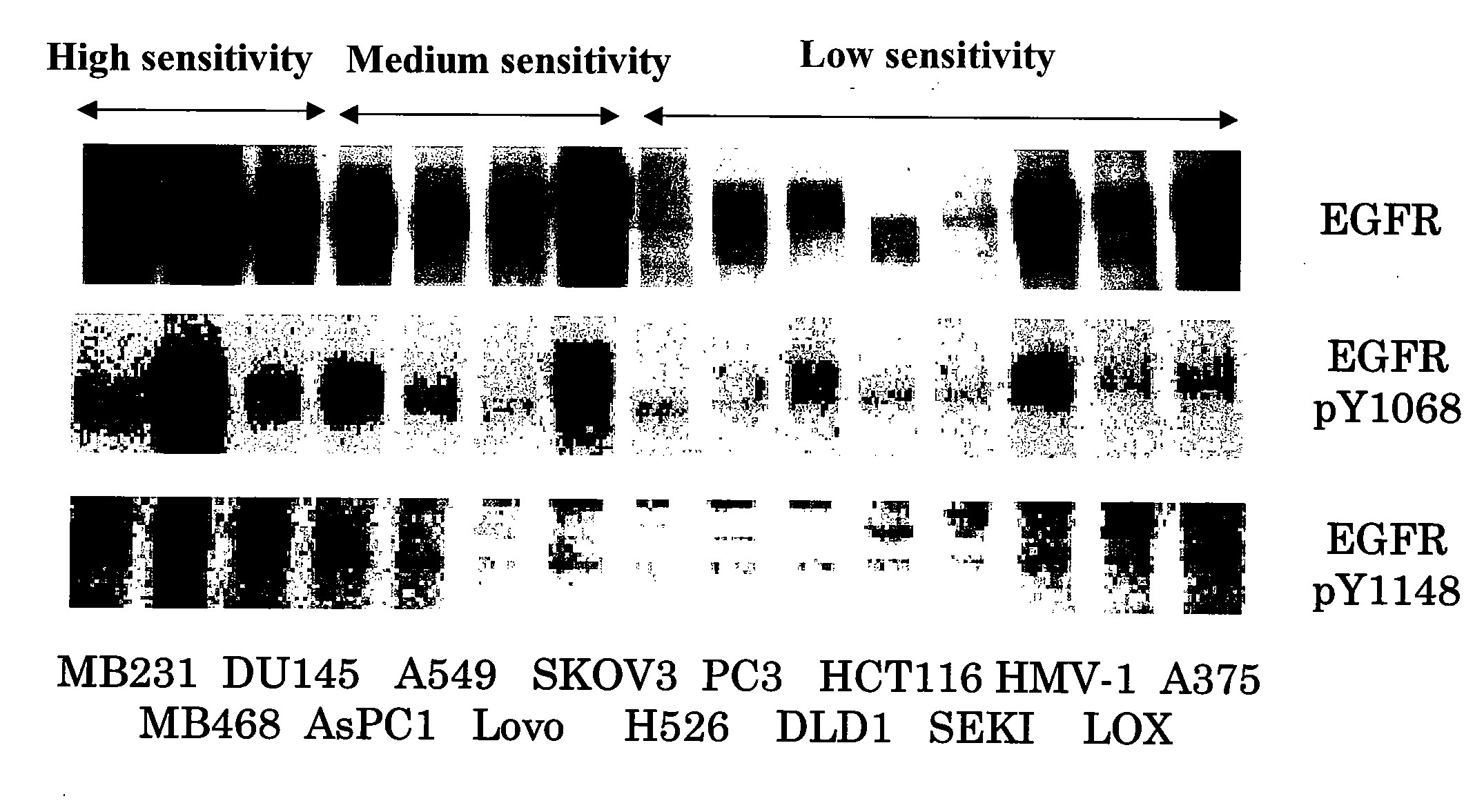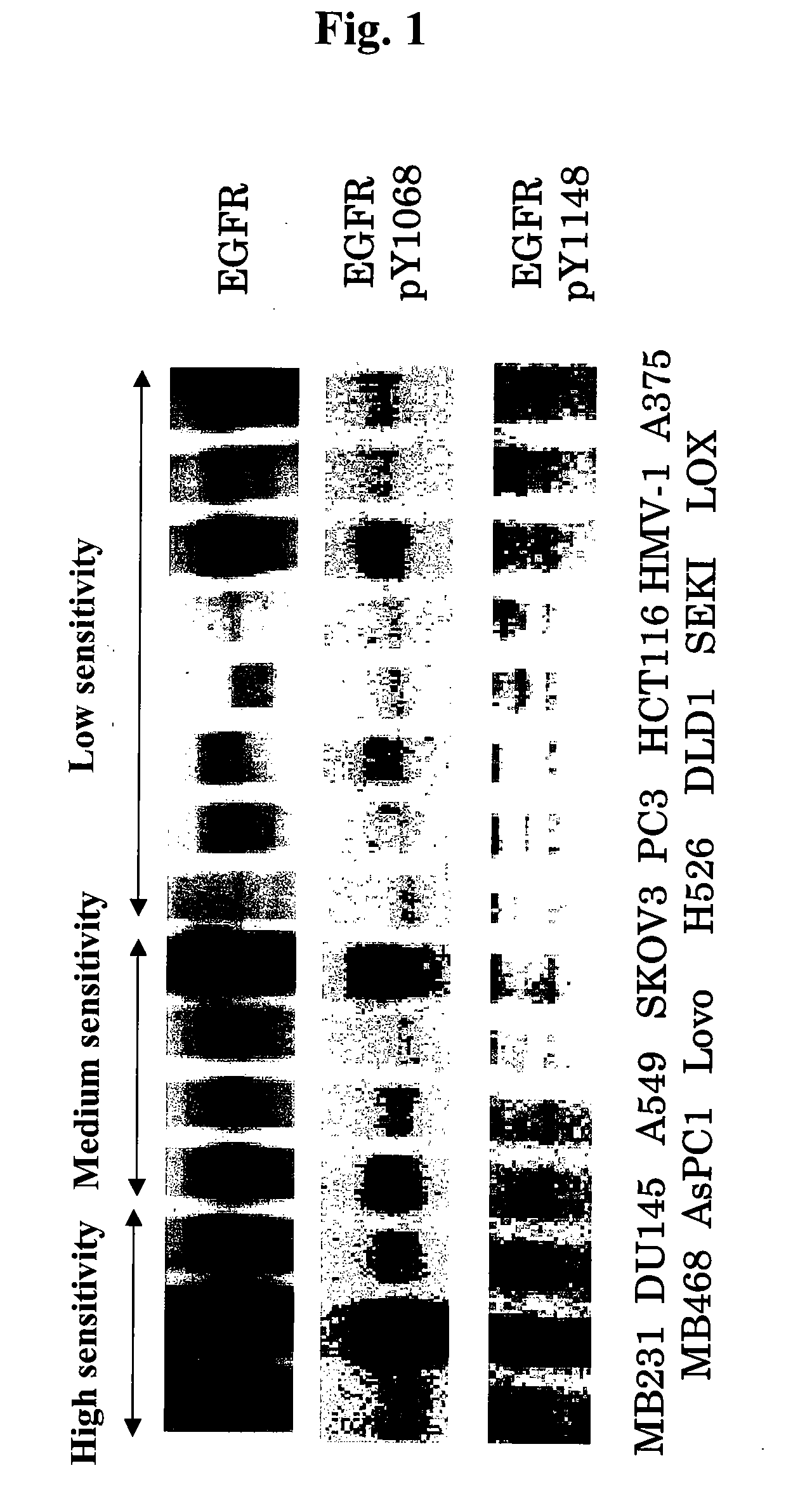Method for assay on the effect of vascularization inhibitor
a technology of angiogenesis inhibitor and assay method, which is applied in the field of new methods can solve the problems of not finding an effective method for predicting the effect of angiogenesis inhibitors prior to administration, and not elucidating what specific substances with vegf inhibitory activity and egf inhibitory activity are effectiv
- Summary
- Abstract
- Description
- Claims
- Application Information
AI Technical Summary
Benefits of technology
Problems solved by technology
Method used
Image
Examples
example 1
Anti-Tumor Effect of VEGF Receptor Kinase Inhibitor in Human Tumor Cell Line Subcutaneous Xenograft Models (In Vivo)
[0503]Human tumor cell lines MDA-MB-231, MDA-MB-468, DU145, AsPC-1 (these four lines were purchased from ATCC), A549 (purchased from Dainippon Pharmaceutical Co., Ltd.), Lovo, SK-OV-3, H526, PC-3, DLD-1, HCT116 (these six lines were purchased from ATCC), SEKI, HMV-1 (these two lines were purchased from JCRB cell bank, National Institute of Biomedical Innovation), LOX (purchased from AntiCancer) and A375 (purchased from Dainippon Pharmaceutical Co., Ltd.) were cultured with RPMI1640 (containing 10% FBS) in a 5% CO2 gas incubator until they reached about 80% confluence. After culturing, cells from each line were recovered with trypsin-EDTA by conventional procedures. The cells were suspended in phosphate buffer to prepare a cell suspension of 1×108 cells / ml or 5×107 cells / ml. Subsequently, 0.1 ml of the cell suspension was subcutaneously transplanted on the flank of each...
example 2
[0506]Analysis of the Expression Levels of EGF Receptor and the State of Phosphorylation of Tyrosine Residues Thereof (pY1068, pY1148) in Human Tumor Cell Line Subcutaneous Xenograft Models (In Vivo)
[0507]Human tumor cell lines MDA-MB-231, MDA-MB-468, DU145, AsPC-1 (these four lines were purchased from ATCC), A549 (purchased from Dainippon Pharmaceutical Co., Ltd.), Lovo, SK-OV-3, H526, PC-3, DLD-1, HCT116 (these six lines were purchased from ATCC), SEKI, HMV-1 (these two lines were purchased from JCRB cell bank, National Institute of Biomedical Innovation), LOX (purchased from AntiCancer) and A375 (purchased from Dainippon Pharmaceutical Co., Ltd.) were cultured with RPMI1640 (containing 10% FBS) in a 5% CO2 gas incubator until they reached about 80% confluence. After culturing, cells from each line were recovered with trypsin-EDTA by conventional procedures. The 15 types of tumor cells (MDA-MB-231, MDA-MB-468, DU145, AsPC-1, A549, Lovo, SK-OV-3, H526, PC-3, DLD-1, HCT116, SEKI, HM...
example 3
[0512]Combined Application of VEGF Receptor Kinase Inhibitor and EGF Inhibitor in Human Non-Small Cell Lung Cancer Cell line (A549) Subcutaneous Xenograft Model (In Vivo)
[0513]Human non-small cell lung cancer cell line A549 (purchased from Dainippon Pharmaceutical Co., Ltd.) was cultured at 37° C. with RPMI1640 (containing 10% FBS) in a 5% CO2 gas incubator until cells reached about 80% confluence. Then, cells were recovered with trypsin-EDTA. A cell suspension (5×107 cells / ml) was prepared with phosphate buffer containing 50% matrigel. The resultant cell suspension was subcutaneously transplanted into the flank of nude (0.1 ml / mouse). From day 10 of transplantation, 4-(3-chloro-4-(cyclopropylaminocarbonyl)aminophenoxy)-7-methoxy-6-quinolinecarboxamide (a methanesulfonate) and erlotinib were orally administered independently or in combination. With respect to 4-(3-chloro-4-(cyclopropylaminocarbonyl)aminophenoxy)-7-methoxy-6-quinolinecarboxamide (a methanesulfonate), it was administe...
PUM
| Property | Measurement | Unit |
|---|---|---|
| size | aaaaa | aaaaa |
| body weight | aaaaa | aaaaa |
| weight ratio | aaaaa | aaaaa |
Abstract
Description
Claims
Application Information
 Login to View More
Login to View More - R&D
- Intellectual Property
- Life Sciences
- Materials
- Tech Scout
- Unparalleled Data Quality
- Higher Quality Content
- 60% Fewer Hallucinations
Browse by: Latest US Patents, China's latest patents, Technical Efficacy Thesaurus, Application Domain, Technology Topic, Popular Technical Reports.
© 2025 PatSnap. All rights reserved.Legal|Privacy policy|Modern Slavery Act Transparency Statement|Sitemap|About US| Contact US: help@patsnap.com



